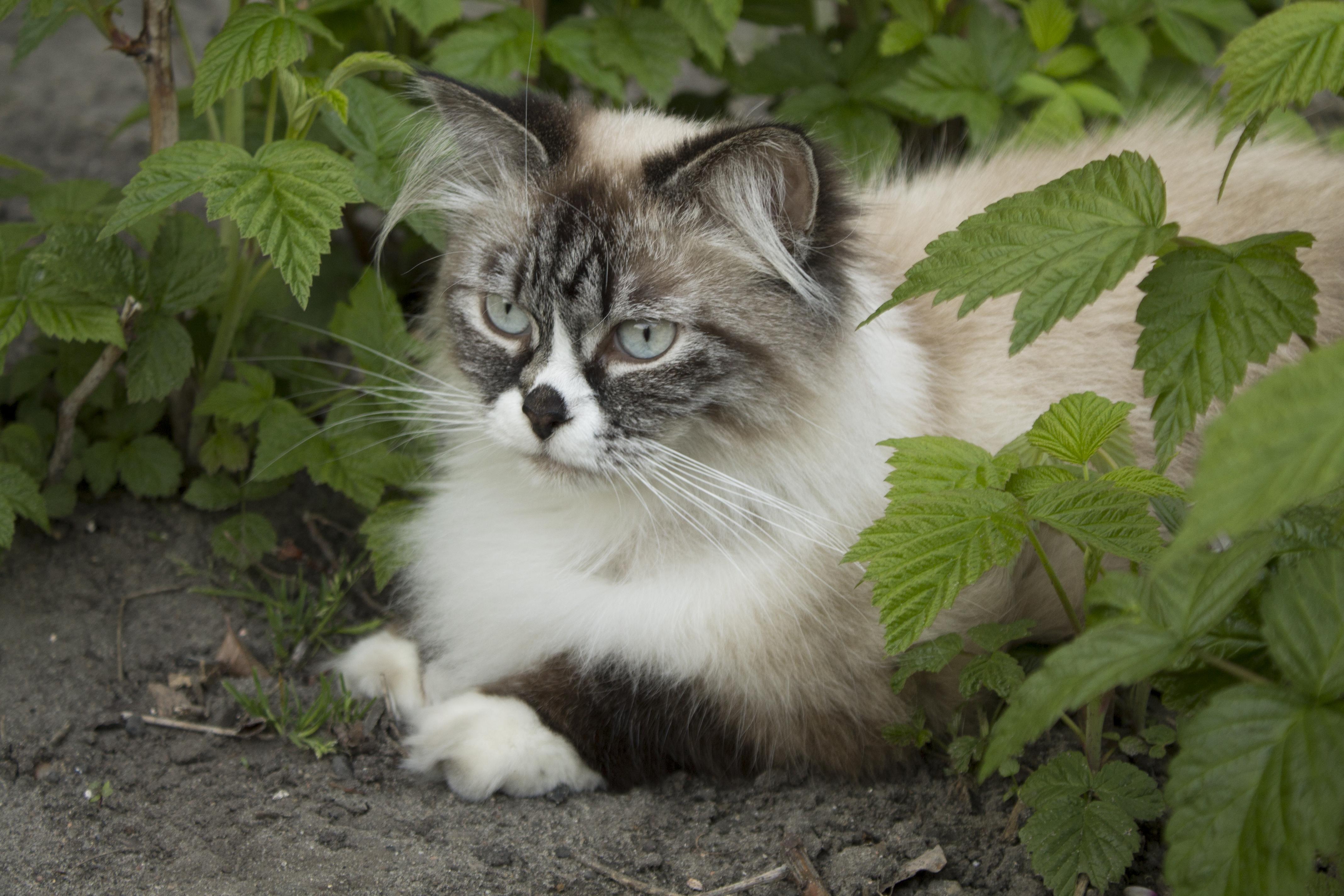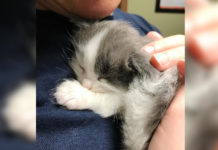Critters everywhere quake at the sight of the Siberian cat. Because this large and powerful cat is more than just a pretty face, it’s also an expert hunter. It is, however, a very handsome cat, renowned for its coat that changes with the seasons. What else should you know about this magnificent breed?
The Siberian Cat In Brief
The first thing you’ll notice about the Siberian is its size. These are large cats. Actually, in cat parlance they’re classified as “medium to large” but it has such an impressive shape and structure, with a broad chest and large paws that even smaller examples can look more imposing than a more common house cat.
If you know your cat breeds you’ll notice an immediate similarity to the Maine Coon and Norwegian Forest cat. That similarity is, however, fairly superficial and on closer inspection you’ll notice that the Siberian can identified by its barrel-like body and wedge shaped head.
Despite its incredibly fluffy appearance the Siberian is actually classed as a semi-longhaired and that beautiful coat is subject to seasonal changes. It is noticeably longer and thicker in winter, including the tail which the cat will coil around its face like a scarf to guard against the cold winter wind. Like similar breeds, the Siberian’s coat comprises of layers; a long, waterproof layer on top and a soft and dense undercoat.
The Siberian comes in a wide variety of color and pattern variations including brown, black, red and white. Including dilute colors caused by cross-breeding you may also see cream and blue variants. These combine with the solid, tortoiseshell and tabby patterning to make well over a hundred combinations.
What’s the Temperament of a Siberian Cat?
Siberian cats are incredibly sweet natured and inquisitive. There’s a real sense of fun about the Siberian and they will often exhibit kitten-like behavior long into adulthood. They retain that sense of playfulness and fun that some breeds can lose.
They make great pets and perhaps surprisingly they adapt well as indoor cats although please bear in mind they’ll need a lot of stimulating games and attention. But the Siberian loves to play so as long as you supply plenty of attention and toys you’ll have a very happy cat.

The Siberian is an intelligent and inquisitive breed that actively seeks out your company no matter what you’re doing. Whether you’re reading a magazine or typing on a laptop you’ll soon find a furry presence eager to take part. Those big paws are well adapted to bat typing fingers.
Unlike most breeds, but in common with their Maine Coon cousins, the Siberian has a real fascination with water. They will often learn to play with faucets or splash around as the last of your shower water drains away. While they don’t usually actively go for a swim, the Siberian has no fear around bodies of water. Best keep an eye on your carp pond.
They wouldn’t thank you for saying it, but the Siberian does possess many attributes that people would naturally associate with dogs. They have a strong bond with their owners and display a decidedly uncat-like loyalty. It’s a very empathetic breed and will respond to your mood in the same way a dog might, providing cuddles when you’re low and fun and games when you’re happy. You can also usually train them to walk on a leash. This set of dog-like characteristics mean they might provide a satisfactory compromise if you’re a cat person and your partner is a dog person.
The Siberian is usually very energetic and athletic although that boundless energy rarely if ever manifests itself in displays of aggression. They’re incredibly mellow and gentle and for that reason are an ideal choice for households where there are children present.
If you think you know what a cat’s meow sounds like think again. The Siberian cat makes a variety of sounds but the one you’ll hear most often is a sort of chirruping that’s half-meow and half-purr. Speaking of purring, this is a cat that purrs like a train. You’ll definitely know when they’re happy.
A Quick Look at the Siberian Cat in Action
If you have a Siberian cat some of the tricks the little guy in this video performs might be familiar to you. I mentioned up above that they possess some dog-like attributes. Well this boy even likes to play fetch! Listen out for that chirruping meow I told you about. You want one don’t you?
What are the Exercise Needs of a Siberian Cat?
The Siberian is an energetic and playful breed. I can’t emphasize enough how much these cats need regular exercise. If you allow access to the outdoors this will take care of itself as the Siberian is a an instinctive and accomplished hunter. As a house cat, however, you’ll need to take a more active role in your pet’s exercise regimen.
Siberians love to play so invest in a variety of toys. Feather toys are a good option and they will happily chase it for as long as you want to wave it in front of them. They are excellent climbers and will take readily to a cat tree. The kind that has places to hide and multiple surfaces will be best, giving your cat a variety of options.
It may sound strange, but Siberians are generally good at learning to walk on a leash. It may take some practice but when your cat starts to associate the collar and leash with walk time they’ll behave much like a dog does.
Failure to adequately stimulate your Siberian cat will result in the destruction of your property. Usually a couch or some shoes. You have been warned.
Is Training a Siberian Cat Easy?
The Siberian cat is an intelligent breed with a great capacity for learning. What’s more they pick things up fast. Cats generally have the reputation for being free-spirited and uncooperative but your Siberian is more likely to view your attempts to train him as a game and will respond accordingly.
The desire to hunt is strong in the Siberian, so a good way to start teaching a new task is to incorporate it into some of those natural hunting behaviors. For example, they will often return a thrown toy, just like a dog. Teach them to drop and sit by offering a reward. Use voice commands and alter your tone to emphasize correct and incorrect behavior.
Some trial and error is always involved. You might implore your cat to perform a certain behavior only for him to ignore you. On the occasion that your cat performs the behavior make sure you have that reward on hand. This will help your cat to associate the command with the behavior and the behavior with the reward.
Lastly, make it fun. Your cat will only do something if they feel like it and no amount of cajoling and coaxing will convince them otherwise. Refrain from shouting or making sudden movements that might distress or alienate your cat. Underneath that cool exterior they have feelings too.
Do Siberian Cats Need Grooming?
The short answer is “not really”. Siberian cats have a long outer layer to their coat and a thicker softer layer underneath. The outer layer is naturally oily and waterproof and this helps to prevent matting from occurring.
I would recommend some light brushing once or twice a week with a soft brush. This is partly to keep the coat in tip top condition but it’s also something that most cats enjoy and will help you to bond with your furry friend.
I wouldn’t recommend bathing your Siberian cat. He may enjoy it but bathing, especially if you use pet shampoo, will strip the coat of its natural oils and it’s very difficult to rinse absolutely every trace of the shampoo away. This could result in dandruff and matting.
The Cost of a Siberian Cat
Siberian kittens can cost somewhere in the region of $1300-$1600. The variation in price is down to the individual appearance of the kitten as some colors and patternations are more popular than others. It can also vary depending on whether the breeder is including spaying, genetic tests or any other veterinary services. You should only buy from a breeder with a solid reputation.





